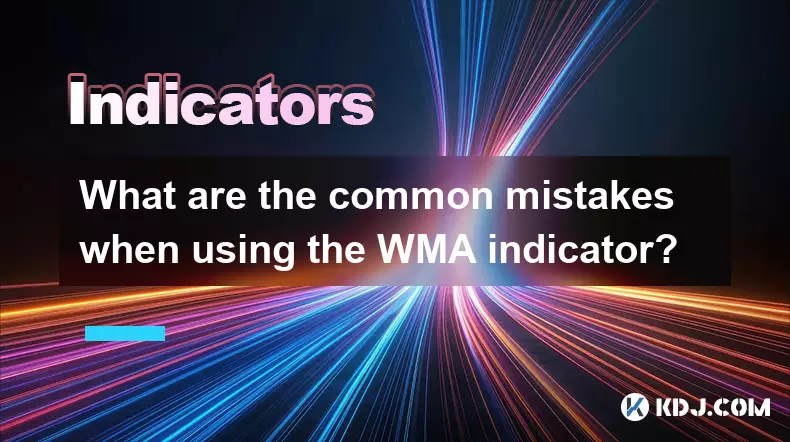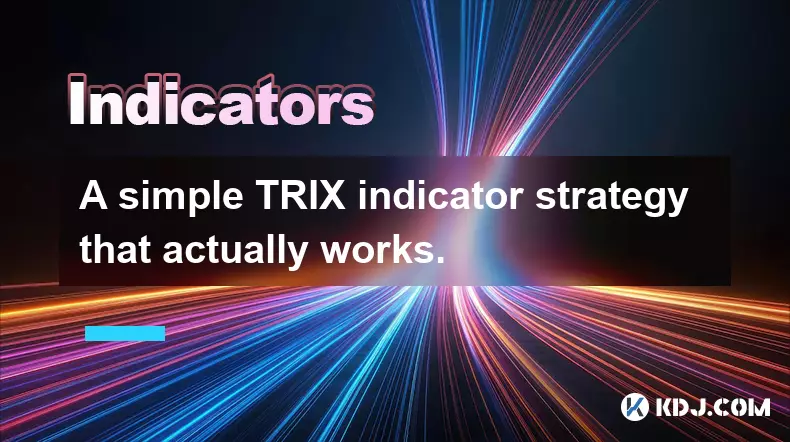-
 bitcoin
bitcoin $102877.190955 USD
1.88% -
 ethereum
ethereum $3430.435064 USD
4.52% -
 tether
tether $0.999264 USD
-0.05% -
 xrp
xrp $2.307310 USD
4.49% -
 bnb
bnb $987.740692 USD
3.82% -
 solana
solana $161.947760 USD
3.97% -
 usd-coin
usd-coin $0.999712 USD
-0.05% -
 tron
tron $0.292810 USD
2.93% -
 dogecoin
dogecoin $0.179738 USD
10.70% -
 cardano
cardano $0.580716 USD
8.75% -
 hyperliquid
hyperliquid $42.463448 USD
8.40% -
 chainlink
chainlink $15.763437 USD
7.05% -
 zcash
zcash $649.595636 USD
17.21% -
 bitcoin-cash
bitcoin-cash $511.610261 USD
7.19% -
 stellar
stellar $0.292537 USD
7.91%
What are the common mistakes when using the WMA indicator?
Relying solely on WMA without confirmation from volume, RSI, or trend analysis can lead to false signals and poor trading decisions in volatile crypto markets.
Nov 08, 2025 at 01:40 am

Overreliance on WMA Without Confirmation
1. Traders often treat the Weighted Moving Average (WMA) as a standalone signal generator, expecting it to predict market turns with high accuracy. The WMA assigns greater weight to recent prices, making it more responsive than the Simple Moving Average (SMA), but this sensitivity also increases the risk of false signals during choppy or sideways markets.
2. Relying solely on crossovers between price and the WMA line can lead to entering trades based on noise rather than genuine momentum shifts. In volatile crypto markets, where sudden pumps and dumps are common, these false breakouts occur frequently.
3. Failing to combine WMA readings with volume analysis, support/resistance levels, or other technical indicators like RSI or MACD significantly reduces its reliability. For instance, a bullish crossover on the WMA carries more weight when accompanied by rising trading volume and oversold conditions on the RSI.
4. Many traders overlook the importance of time frame alignment. Using a short-term WMA on a 15-minute chart without checking the direction of the longer-term WMA on the 4-hour or daily chart may result in counter-trend entries that go against broader market momentum.
Misinterpreting WMA Slope and Direction
1. A common error is assuming that any upward slope in the WMA automatically indicates a buy opportunity. While an ascending WMA suggests bullish momentum, it doesn’t confirm whether the asset is overextended or approaching a key resistance zone.
2. Conversely, a downward-sloping WMA isn’t always a sell signal—especially in strong bull runs where temporary pullbacks cause the WMA to dip before resuming its uptrend. Blindly shorting based on slope changes can be dangerous in trending crypto assets.
3. Traders frequently ignore the rate of change in the WMA’s angle, which provides insight into acceleration or deceleration of price movement. A flattening WMA after a steep rise may indicate weakening momentum, even if the price remains above the average.
4. Misjudging consolidation phases as trend reversals leads to premature exits or entries. During periods of low volatility, the WMA tends to move sideways, which some interpret as a bearish development when it's merely reflective of market equilibrium.
Incorrect Period Settings for Market Conditions
1. Applying default WMA settings across different cryptocurrencies without adjusting for their unique volatility profiles is a widespread mistake. High-volatility tokens like meme coins require different smoothing periods compared to more stable large-cap assets like Bitcoin or Ethereum.
2. Using too short a period makes the WMA overly reactive, generating numerous whipsaws in ranging markets. On the other hand, excessively long periods reduce responsiveness, causing delayed signals that miss optimal entry and exit points.
3. Many traders fail to adapt WMA lengths according to evolving market regimes—such as shifting from trending to consolidating environments. A 20-period WMA might work well in a strong uptrend but perform poorly during a tight range-bound phase common in bear markets.
4. There’s no universal “best” WMA setting. Optimal parameters depend on trading style—scalpers may use 10-period WMAs, while swing traders prefer 50 or 100-period versions. Choosing inappropriate lengths distorts signal quality and undermines strategy consistency.
Frequently Asked Questions
Can the WMA be used effectively in crypto bear markets?Yes, but with caution. In downtrends, the WMA can help identify resistance levels where price bounces fail. However, rallies above the WMA should be viewed skeptically unless confirmed by strong volume and fundamental catalysts.
How does WMA differ from EMA in cryptocurrency trading?Both prioritize recent prices, but WMA applies linear weighting, giving the most recent data point the highest multiplier. EMA uses exponential smoothing, which reacts faster to new information. In fast-moving crypto markets, EMA often generates earlier signals, while WMA offers slightly smoother tracking.
Should I use multiple WMA lines on the same chart?Using dual or triple WMA lines (e.g., 20 and 50 periods) can highlight crossovers and dynamic support/resistance zones. However, adding too many creates visual clutter and conflicting signals, especially in low-trending conditions typical of altcoin markets.
Disclaimer:info@kdj.com
The information provided is not trading advice. kdj.com does not assume any responsibility for any investments made based on the information provided in this article. Cryptocurrencies are highly volatile and it is highly recommended that you invest with caution after thorough research!
If you believe that the content used on this website infringes your copyright, please contact us immediately (info@kdj.com) and we will delete it promptly.
- Ripple (XRP) in 2026: Hold or Fold? A Look at XRP's Future and Emerging DeFi Alternatives
- 2025-11-08 18:35:01
- Zcash ZEC Coin Price Explosion: From Privacy Niche to Center Stage
- 2025-11-08 18:55:01
- Berachain Price Prediction: Navigating the Honeycomb Hype in Crypto
- 2025-11-08 18:55:01
- Arthur Hayes, Gold, and Bitcoin: A Modern Monetary Trinity?
- 2025-11-08 19:15:01
- Shiba Inu's Next Move: Navigating a Shifting Market
- 2025-11-08 19:20:01
- Pakistan's Crypto Crossroads: Balancing Opportunity with Asset-Backed Realities
- 2025-11-08 19:20:01
Related knowledge

How do professional traders use the TRIX indicator?
Nov 06,2025 at 04:40pm
Understanding the TRIX Indicator in Crypto TradingThe TRIX (Triple Exponential Average) indicator is a momentum oscillator used by professional trader...

Can I use the TRIX indicator on my mobile trading app?
Nov 07,2025 at 07:40pm
The TRIX indicator, a momentum oscillator designed to filter out short-term fluctuations and highlight long-term trends, has become increasingly popul...

How to code a simple TRIX indicator script in Pine Script?
Nov 07,2025 at 06:20am
How to Code a Simple TRIX Indicator in Pine Script The TRIX (Triple Exponential Moving Average) indicator is widely used in cryptocurrency trading to ...

A simple TRIX indicator strategy that actually works.
Nov 08,2025 at 05:39pm
Understanding the TRIX Indicator in Crypto Trading1. The TRIX (Triple Exponential Average) indicator is a momentum oscillator designed to filter out s...

How to trade TRIX indicator signals on the 1-hour chart?
Nov 07,2025 at 05:39am
Bitcoin's Role in Decentralized Finance1. Bitcoin remains the cornerstone of decentralized finance, serving as a benchmark for value and security acro...

Can the TRIX indicator be used for long-term investing?
Nov 06,2025 at 02:19pm
Understanding the TRIX Indicator in Cryptocurrency Markets1. The TRIX (Triple Exponential Average) indicator is a momentum oscillator designed to filt...

How do professional traders use the TRIX indicator?
Nov 06,2025 at 04:40pm
Understanding the TRIX Indicator in Crypto TradingThe TRIX (Triple Exponential Average) indicator is a momentum oscillator used by professional trader...

Can I use the TRIX indicator on my mobile trading app?
Nov 07,2025 at 07:40pm
The TRIX indicator, a momentum oscillator designed to filter out short-term fluctuations and highlight long-term trends, has become increasingly popul...

How to code a simple TRIX indicator script in Pine Script?
Nov 07,2025 at 06:20am
How to Code a Simple TRIX Indicator in Pine Script The TRIX (Triple Exponential Moving Average) indicator is widely used in cryptocurrency trading to ...

A simple TRIX indicator strategy that actually works.
Nov 08,2025 at 05:39pm
Understanding the TRIX Indicator in Crypto Trading1. The TRIX (Triple Exponential Average) indicator is a momentum oscillator designed to filter out s...

How to trade TRIX indicator signals on the 1-hour chart?
Nov 07,2025 at 05:39am
Bitcoin's Role in Decentralized Finance1. Bitcoin remains the cornerstone of decentralized finance, serving as a benchmark for value and security acro...

Can the TRIX indicator be used for long-term investing?
Nov 06,2025 at 02:19pm
Understanding the TRIX Indicator in Cryptocurrency Markets1. The TRIX (Triple Exponential Average) indicator is a momentum oscillator designed to filt...
See all articles





















![The Graph Price Prediction [GRT Crypto Price News Today] The Graph Price Prediction [GRT Crypto Price News Today]](/uploads/2025/11/07/cryptocurrencies-news/videos/690d4df44fe69_image_500_375.webp)



















































